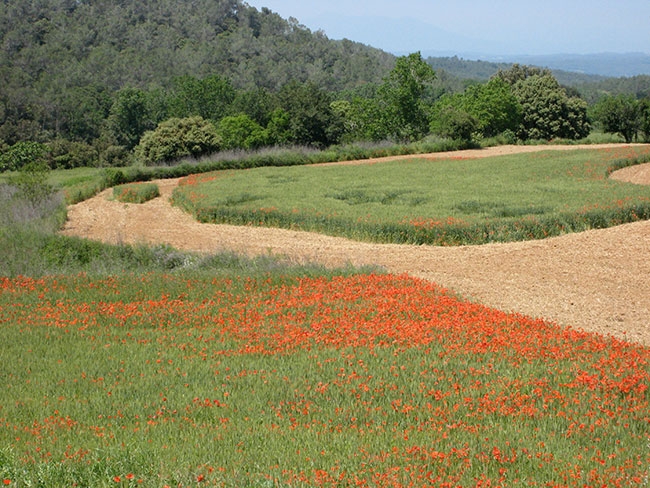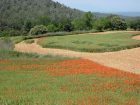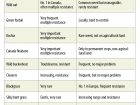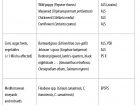
Features
Herbicides
Seed & Chemical
The emergence and status of herbicide resistance in Europe and its management
The first resistant population identified in Europe was a pigweed resistant to atrazine in Austria in 1973. Later on through the 1980s and 1990s, many weed species developed resistant to PSII inhibitors (Group 5), mostly to atrazine. More recently, there has been a dramatic increase in resistance to ACCase (Group 1) and ALS (Group 2) inhibitors in grasses since 1990.
May 15, 2018 By Presented by Josef Soukup Czech University of Life Sciences Prague at the Herbicide Resistance Summit Saskatoon Feb. 27-28 2018.
 Wild poppy is one weed that has developed resistance to ALS herbicides. The first resistant population identified in Europe was a pigweed resistant to atrazine in Austria in 1973.
Wild poppy is one weed that has developed resistance to ALS herbicides. The first resistant population identified in Europe was a pigweed resistant to atrazine in Austria in 1973.Resistance to ALS herbicides has been confirmed since 2000 in broadleaved weeds like mayweed and wild poppy. Resistance to glyphosate (Group 9) has also developed in permanent crops like orchards and vineyards in the Mediterranean since 2000. Glyphosate resistance is the major problem in the Mediterranean.
The most important crops affected by resistance are cereals. For Europe, the weedy grasses – blackgrass, silky bent grass, wild oats, Italian ryegrass, and brome species – are the problems. The area affected is about 10 million hectares. Compared to Canada, with roughly 15 million hectares affected by resistance, the area is very comparable, but we have twice the area of arable land.
Some smaller areas are affected by resistance in broadleaved crops, such as sugar beets and vegetables. The area is less than one million hectares. In other summer crops, there are different weed problems, again, grasses – barnyardgrass and Johnson’s grass – in corn and also in sugar beet.
Resistance in grain cereals
The most important weed in cereals for Europe is blackgrass (Alopecurus myosuroides), especially in the United Kingdom, France, and Germany. It affects the crop once established in the fall, and is very competitive at tillering, overwinter, and in the spring. High infestation can result in 80 per cent yield loss. In United Kingdom and France, about 80 per cent of populations are resistant. In Germany, about 50 per cent of populations are resistant, usually to ACCase inhibitors but also ALS inhibitors. There is also resistance against the newer products like mesosulfuron (Group 2) and pyroxsulam (Group 2). Farmers must now once again include soil active herbicides, such as prosulfocarb (Group 8) and flufenacet (Group 15) that are applied in the fall.
Silky bent grass is in Central and Northwestern Europe. Resistance to ALS is the most frequent with some ACCase resistance occurring. Fortunately, our soil herbicides like flufenacet, prosulfocarb, and chlorotoluron (Group 7) are effective on these resistant populations. One population in Czech Republic in 2017 was confirmed to be resistant to three modes of action, ALS, ACCase and PSII herbicides.
Ryegrass is a typical problem of the ocean climate – United Kingdom, France, and Germany. Usually, it is the Lolium multiflorum – Italian ryegrass. L. perenne occurs in the southern part of Europe. It is competitive and very prone to mutations and metabolic resistance, resulting in quick selection for ALS and ACCase resistance.
Wild oat is not as frequent in Europe because we usually grow winter crops. It is usually found in southern part of Europe, not Avena fatua but Avena sterilis and Avena ludoviciana. It quite frequently has resistance to ALS and ACC inhibitors. The problem is that triallate is not allowed in Europe, and alternative modes of action that can be used against these resistant biotypes are not available.
Brome species is a quite new issue in Europe, but it is spreading very quickly. A few resistant populations to ALS have been found in United Kingdom and in Spain. Brome species are also exhibiting a decreasing sensitivity to glyphosate because farmers use glyphosate in burndown control. It is not considered resistant, but the sensitivity is lower and lower.
In some Western European countries, ALS resistant mayweed (Tripleurospermum perforatum) has been found. It is a very difficult weed in cereals and oilseed rape.
Wild poppy is already resistant to ALS inhibitors, but some populations were also found to be resistant to synthetic auxins (Group 4). This resistance to synthetic auxins is a problem because many products used in spraying are a combination of ALS inhibitors – usually florasulam with 2,4-D or other auxins.
Less important resistant species in cereals are chickweed and cornflower. Few populations of chickweed have resistance to ALS inhibitors and rarely PSII and auxins. Cornflower is a very competitive weed on sandy soils in Poland and Germany and is tolerant to ALS inhibitors in some areas.
There are several factors driving resistance in small grain cereals. Winter cropping is a big problem because the period between crops when weeds can be controlled is very short. A typical crop rotation is winter wheat followed by winter barley and then winter oilseed rape. Oilseed rape stays on the field for 11 to 12 months. There is only one week or two weeks for weed control between the crops. This is a challenge for perennial weed control and control of different resistant weeds that survive in-crop treatments. Usually, resistant winter annual grasses survive an herbicide application, shed seeds and immediately emerge in the subsequent crop.
The reliance on ALS and ACCase inhibitors is also a problem. We have too many ALS inhibitors used in weed control, and are about half of the all compounds used.
Our farms are also growing larger, and we are using more reduced tillage. Minimum tillage favours almost all the grasses. The combination of a narrow crop rotation and minimum soil tillage is now regarded as a multiplicator of the risk, especially from the point of view of the occurrence of winter grasses.
Resistance in corn
Corn is grown for grain and silage production. Overall, resistant weeds in corn are not an issue in Europe. Barnyard grass resistant to ALS herbicides occurs mainly in Italy, Spain and Hungary. Johnson’s grass, which is a perennial, has also developed resistance to ALS inhibitors. Farmers successfully use cycloxydim-tolerant (Group 1) corn varieties to control ALS-resistant grasses, since resistance against ACCase inhibitors has not yet developed.
In Czech Republic, some PS II inhibitors, such as terbuthylazine, are used in corn, although atrazine was banned few years ago. Terbuthylazine is a very cheap solution, but a recent survey found many PSII resistant populations of redroot pigweed. Interestingly, after many years of use of ALS inhibitors and other mode of actions, these PSII resistant populations still occur.
Glyphosate use and resistance
Europe doesn’t grow glyphosate-tolerant crops, so it is used on arable land as between crop applications and as a pre-harvest application. In Czech Republic, glyphosate accounts for about 17 per cent of the total consumption of pesticides, which is not as high as in America. There is no glyphosate-resistance on arable land.
However, some resistance has been identified in permanent crops in Mediterranean, where citrus, olive, and grapevine are grown. Farmers rely only on glyphosate. The most important species are fleabanes – Canadian and Sumatran fleabane.
Factors regarded as glyphosate resistance drivers in permanent crops are very dense populations of a single species prone to resistance development; limited number of registered herbicides and a reliance on glyphosate; too late applications; unfavourable conditions for applications; and ignorance of non-chemical methods. Some alternative solutions must be implemented in orchards and in permanent crops to be able to control the weeds in the future.
Many glyphosate-resistant populations also occur on non-agricultural land, which can be an issue. These populations can spread on agriculture land. One weed, Asiatic dayflower (Commelina communis), which is very naturally tolerant to glyphosate and can survive 32 litres per hectare, was also found on railways.
On the other hand, glyphosate is very important because it diversifies the choice of mode of action to control ALS- and ACCase-resistant weeds on arable land.
Introduction of glyphosate-tolerant crops is not expected in the near future. Glyphosate is recently under big political pressure by NGOs and different political streams. It is an issue from the regulatory point of view. Glyphosate received a renewal for the next five years, but we do not know what will happen after that five years. We expect very strong limitations on glyphosate use in coming years.
Research and communications
In Europe we have very similar networks for resistance monitoring, scouting, and mapping. Within the European Weed Research Society, the Weed Mapping working group and Herbicide Resistance working group operate. They communicate the resistance problem amongst scientists, industry, and governmental bodies. There is also a European Herbicide Resistance Action Committee (EHRAC; www.ehrac.org).
Legislation
Legislation is used for the authorization and sustainable use of the pesticides. There are many regulations and directives. Some directives focus on placing of the plant protection products on the market, and other on the sustainable use of these products by farmers.
The European and Mediterranean Plant Protection Organization develop standards for testing of plant protection products and evaluating resistance risk. The standard describes how the risk of the resistance to plant protection products can be assessed and how they can be managed after the regulation of the product and placing of the market.
There are two types of the risk: inherent risks and agronomic risks. Both are considered in the registration process. The applicant and registration body first evaluate the inherent risk of the product. This is the risk assessment stage, and if there is no risk or the risk is small, the registrant establishes the baseline sensitivity, registers their product, and then follows the monitoring risk after the registration. If there is an inherent risk, there must be some resistance risk management proposed, and it is placed on the label.
There are very important directives for the sustainable use of the pesticides, and individual countries have to create national action plans for reduction of the risk and impacts of the pesticides on human health and on the environment. These should ensure appropriate training of farmers, testing of the application equipment, and implement the methods of integrated pest management. Some general principles of integrated managements are well known, such as prevention and suppression of harmful organisms and monitoring. Some rules are for decision-making, such as which measures are more appropriate. The pesticides should be applied as specific as possible so that it doesn’t affect the non-target organisms. Where the risk of the resistance against the plant protection measure is known and where the level of harmful organisms requires repeated applications, available anti-resistance strategies should be applied.
All countries develop national action plans. For example, rules for application of pesticides, measures to protect aquatic environments, reduction of the risk, and integrated pest management.
Some countries developed additional measures, like a pesticide tax, which is sometimes a problem for the farmers because this is a disadvantage to have a tax at the national level. The second problem is that it can be controversial and counter-productive because a mode of action, which is prone to resistance, such as ALS inhibitors, has lower taxes than other products that are not so prone to resistance.
European farmers get many supports and many payments, but they must fulfill basic standards concerning the impact on the environment. They should maintain good agriculture and environmental conditions. They receive direct payments. They receive, additionally, green payments that promote practices that are beneficial for the environment and for climate. There are also some agri-environment measures where payments are made to farmers who subscribe to measures related to the preservation of the environment and maintaining the countryside.
Very important for farmers now are the payments for “greening,” which is quite high, with 30 per cent of direct payments since 2015. Greening means farms have to diversify crop rotations. Farms up to 30 hectares have to grow at least two crops. Bigger farms must have at least three crops. To get the subsidy, all farms must keep five per cent of the farm with an ecological focus that uses some direct measure like fallow land, field margins, hedges and trees or buffer trips. Or they can grow catch crops or legumes. A problem starting in 2018 is that pesticides may not be applied to the ecological focus area. Also, permanent grassland cannot be ploughed or converted anymore.
Lessons learned
The patterns leading to the development of herbicide resistance are the same everywhere. Factors leading to the resistance:
- Simplification of crop rotations.
- Prevalence of one crop type – in our case, winter crops.
- Increase of population densities of weed species associated with crops creates higher probability of the development of the resistance.
- Species with high fecundity, long distance dispersion, and dense offspring are more prone to the development of the resistance.
- Overuse of the same mode of action like ALS inhibitors and ACCase inhibitors.
- Non-chemical methods are hardly applicable or not reliable fully. It is difficult to combine chemical and non-chemical methods.
- Environmental regulations can be sometimes counterproductive
- What is good for environment and for human health is not necessarily good from the point of view of the development of the resistance.
For the outlook on further management of herbicide resistance, everybody recommends more diverse management strategies. They are necessary and may prolong the effectiveness of herbicides, but crop diversity is decreasing everywhere, at the global level, at the local level, and according to market demands. Thus it is very hard to include new crops in crop rotations. Prices are set at the global level, and farmers may not create a sufficient margin for prevention of the herbicide resistance. They have to prefer cheaper short practices or tactics before the long-term strategies.
Resistance is also an environmental and social issue. I think public attention should contribute to the problem and support research institution networks, and transfer of knowledge. Acceptable regulations can help, but over-regulations can be often counterproductive. Farm management shouldn’t be a subject of regulation because it’s burdening, embarrassing, and sometimes costly, and the effect is not clear. Science can contribute to solving the problem. Farmers must look for latest knowledge in professional journals, fact sheets, and advisors and make scientifically based decisions. However, “thousands of small hammers” of traditional farming practices can help. We must learn from nature and field history and prepare efficient local recommendations.
Technological advance can help deliver new solutions to overcome the problems in the longer term because we will have new strains, new formulations, more precise application technique, equipment for strategic tillage, and harvest weed management. New tools will also support the remote detection of resistance and provide a decision support system. I am optimistic for the future, and think resistance won’t necessarily have to impact yields and production.
For more stories on this topic, check out Top Crop Manager’s Focus On: Herbicide Resistance, the first in our digital edition series.


